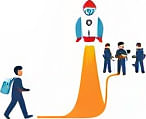From Freelance Design to Ecommerce Startup: A Path to Business Growth
 by Thaddeus Blanda
by Thaddeus Blanda
Discover how freelance designers can build an ecommerce startup for greater independence and success. This guide covers key steps, challenges, and strategies to turn your skills into a thriving business, inspiring freelancers to take the next step.

Many freelancers in design fields dream of expanding beyond individual projects. This shift to an ecommerce startup offers a way to scale skills and achieve lasting business independence. For those with design expertise, creating an online store can leverage their talents effectively.
Starting with your design background provides a solid foundation. As a freelance designer, you already handle client needs and create visuals that attract attention. Now, imagine applying these abilities to sell products directly. This move allows for consistent revenue streams and broader reach.
One essential step is identifying your niche. Focus on areas where your design skills shine, such as custom graphics or merchandise. By selecting a specific market, you build a brand that stands out. For example, if you specialize in eco-friendly designs, target consumers who value sustainability.
Next, develop a business plan. This document outlines your goals, target audience, and financial projections. A clear plan helps secure funding if needed and keeps your efforts organized. Include details on how your design expertise will drive sales in the ecommerce startup.
Building an online presence is crucial. Choose a platform like Shopify or WooCommerce to set up your store. Use your design skills to create an appealing website that showcases products effectively. Ensure the site is user-friendly and optimized for mobile devices, as this influences customer satisfaction.
Key Steps for Launching Your Startup
To make the transition smooth, follow these practical steps:
- Assess your resources: Review your current skills and tools. Determine what additional resources, like software or partnerships, are necessary.
- Create a product line: Start by designing items you can sell, such as digital downloads or physical goods. Test ideas with a small audience to gather feedback.
- Handle finances: Set up accounting systems early. Track expenses and income to maintain stability as your business grows.
- Build a team: While freelancing is often solo, a startup benefits from collaboration. Hire freelancers or partners for areas outside your expertise, like marketing.
- Market your offerings: Use social media and email campaigns to promote your products. Your design background gives you an edge in creating eye-catching content.
Challenges may arise during this process. For instance, managing time between freelance work and startup demands can be tough. Prioritize tasks and set boundaries to avoid burnout. Another issue is competition in the ecommerce space. Differentiate your brand through unique designs that reflect your personal style.
Success stories from former freelancers show this path is achievable. One designer turned a side project into a full-fledged online store by focusing on personalized home decor. They used their skills to create exclusive items, leading to steady growth and business independence.
To stay motivated, set small milestones. Celebrate each achievement, like launching your first product or reaching a sales goal. Remember, this journey builds on your existing talents, turning freelance design into a sustainable venture.
Legal aspects are also important. Register your business and understand tax obligations to protect your interests. Consult resources or professionals for guidance without overwhelming yourself.
In practice, scaling from freelance to startup involves continuous learning. Stay updated on industry trends through online courses or communities. This knowledge helps refine your strategies and adapt to changes.
Ultimately, the transition fosters business growth and personal fulfillment. By leveraging your design skills in an ecommerce context, you create opportunities for expansion and innovation. Take the first step today and watch your freelance experience evolve into something greater.
